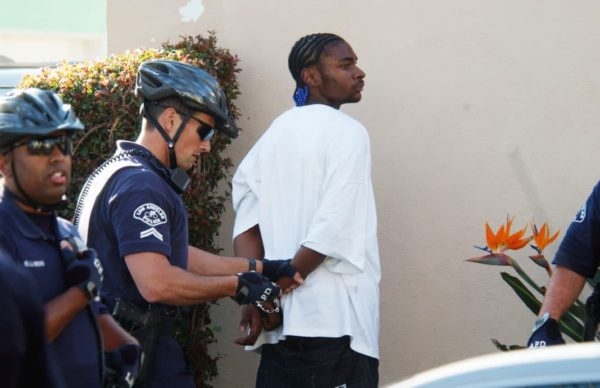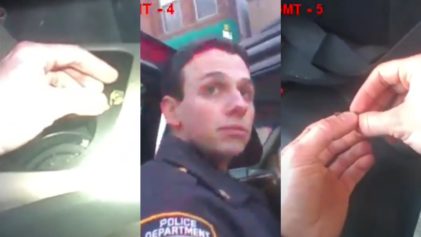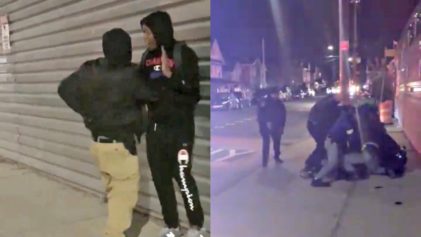
LOS ANGELES – JANUARY 20: Police arrest a man after mounted police in riot gear, attempting to clear a street, charged at spectators following a peaceful Martin Luther King Day parade January 20, 2003 in Los Angeles, California. (Photo by David McNew/Getty Images)
Entangled in controversy, you would think the infamous New York Police Department would have enough things to worry about, including a recent leaked file that revealed hundreds of officers had been allowed to remain on the job following a string of fireable offenses. According to a new report however, research indicates that there’s something else on the minds of some officers, namely, a fear of tall African-American men.
Yes, you read that right.
Published by the Proceedings of the National Academies of Science, the study — conducted by University of North Carolina psychology professor Kurt Gray and social psychology graduate student Neil Hester — concluded that being a tall Black man increases the likelihood of being profiled by white New York Police officers.
According to the study, “Young Black men are stereotyped as threatening, which can have grave consequences for interactions with police. We show that these threat stereotypes are even greater for tall Black men, who face greater discrimination from police officers and elicit stronger judgments of threat. We challenge the assumption that height is intrinsically good for men. White men may benefit from height, but Black men may not.”
It also found that, “Height seems beneficial for men in terms of salaries and success; however, past research on height examines only White men. For Black men, height may be more costly than beneficial, primarily signaling threat rather than competence. Three studies reveal the downsides of height in Black men.”
And if perception is everything, simply being perceived as “more threatening” can unfortunately have deadly consequences for those on the receiving end of such stereotypes, as seen in cases like Tamir Rice, in which the 195-pound 12-year-old was immediately deemed older than he actually was, Black boys in particular are at greater risk of facing dire consequences when placed in such scenarios.
As Gray and Hester found, “Height amplifies already problematic perceptions of threat, which can lead to harassment and even injury.”
The NYPD has long struggled to overcome such accusations, bolstered in part by complaints from within their own ranks, in which Black detectives filed a lawsuit claiming that race often played a factor in being denied promotions, an issue that retired Detective Jon McCollum described to New York Daily News as, “I did everything I could to get promoted. I watched countless white detectives from my class move up in rank, but not me. Multiple supervisors told me if I were white I would have been promoted.”
Black New Yorkers have also found themselves on the receiving end of such bias, thanks in part to the NYPD’s notorious stop-and-frisk policies that have disproportionately affected Black and Latino residents. As a New York Civil Liberties Union report found, in the first quarter of 2017 alone residents were stopped 2,862 times. Of those numbers, “1,892 were total innocent (66 percent)” and “1,618 were black (57 percent).”
“An analysis by the NYCLU revealed that innocent New Yorkers have been subjected to police stops and street interrogations more than 5 million times since 2002, and that black and Latino communities continue to be the overwhelming target of these tactics. Nearly nine out of 10 stopped-and-frisked New Yorkers have been completely innocent,” the report revealed.
While New York’s controversial stop-and-frisk policy has been deemed unconstitutional, efforts to eradicate the practice have fallen short. Instead, officers are now forced to keep a paper trail of authorized stops. But due to the rampant bias found, Gray and Hester’s findings are even more unsettling.
As the Los Angeles Times reported, during the study, participants shown images of Black men showed implicit bias proving “Black men in the pictures were consistently ranked as more threatening than white men. That was especially true when the pictures made them appear taller — the black men were judged to be more menacing, while white men were judged to be more competent.
“Among people who already perceived black men as threatening, the taller the black men got, the more threatening they seemed. This was true for both male and female participants, the authors found,” they added.
These findings are similar to a string of studies that have indicated that Black people, as a whole, are seen by many as more dangerous than others. An American Psychological Association study also showed that “Black men tend to be stereotyped as threatening and, as a result, may be disproportionately targeted by police even when unarmed. Here, we found evidence that biased perceptions of young Black men’s physical size may play a role in this process. The results of seven studies showed that people have a bias to perceive young Black men as bigger (taller, heavier, more muscular) and more physically threatening (stronger, more capable of harm) than young White men.”
Its conclusions are telling, with research indicating that “Such perceptions may have disturbing consequences for both how civilians and law enforcement personnel perceive and behave toward Black individuals.”
In short, when it comes to racial bias, Black Americans are often seen as “more dangerous,” even when no such threat exists.


